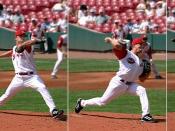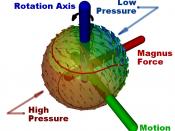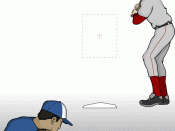The fastest pitch ever officially recorded in a major league baseball game was 100.9 mph set by Nolan Ryan in 1974. This all happens by a few charismatic events that take place while throwing a baseball. I will explain a few of these today. First, the air dynamic behind the curve ball and second how to throw a curve ball. This will entail the proper grip on the ball and also the proper arm and wrist movement. My ultimate goal of this project is not only to teach younger people how to throw, but to show older people the stresses that come with throwing many curveballs.
The theory dynamics of air are very complicated to describe, as are the physics of an object in projectile motion. Together they provide us with a simple game called baseball. A baseball is a very unique object. It is 9 inches in circumference with stitching in a curved pattern all the way around it.
When this ball is thrown the seam cuts the air. Each time the seam makes a turn through the air it makes a little ripple in the air above the ball. Also if the ball has topspin on it the seams will carry air up from below the ball creating an area of lower pressure below the ball (Throwing). This in turn will cause the ball to dive when the amount of pressure of the ball reaches a certain point. This point usually occurs about 3 feet in front of the batter. Gravity also has an effect on the ball. Gravity makes things move faster over time, so it affects the ball more as it nears home plate (Benson). When the ball starts getting closer to the batter gravity is the higher force, and it can pull a ball down...


